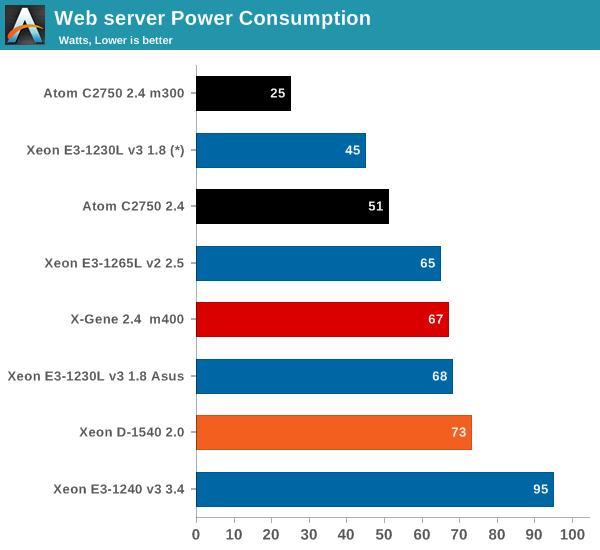The Intel Xeon D Review: Performance Per Watt Server SoC Champion?
by Johan De Gelas on June 23, 2015 8:35 AM EST- Posted in
- CPUs
- Intel
- Xeon-D
- Broadwell-DE
Web Infrastructure Power consumption
Next we tested the system under load.

(*) measured/calculated to mimic a Xeon-E3 "m300-ish" board.
Let us entangle the results by separating the power that goes to the SoC and the power that goes to the system. We did a similar though experiment in our X-Gene 1, Atom C2000 and Xeon E3 comparison.
| Power Consumption SoC Calculations | ||
| SoC | Power Delta = Power Web - Idle (W) |
Power SoC = Power Delta + Idle SoC + Chipset (W) |
| Xeon E3- 1240 v3 3.4 | 95-42 = 53 | 53+3+3 = 59 |
| Xeon E3-1230L v2 1.8 | 68-41 = 27 (45-18 = 27) |
27+3+3 = 33 |
| Xeon D-1540 | 73-31 = 42 | 42+2+0 = 44 |
| Atom C2750 2.4 | 25-11 = 13 | 13+3+0 = 16 |
Now let us combine our calculated SoC power consumption and the power measurements in the graph above. The Atom C2750 still make sense in a micro server if CPU performance is not a priority: think static webservers and caching servers. You can fit an Atom C2750 server inside a power envelop of 25W as HP has proven. Based upon our own experience, such a Xeon D system would probably require more like 55 - 60 W.
If CPU performance is somewhat important, the Xeon D is the absolute champion. A Xeon E3-1230L server with similar features (2x 10 Gb for example) will probably consume almost the same amount of power as we have witnessed on our Asus P9D board (68 W). Given a decently scaling application with enough threads or some kind of virtualization (KVM/Hyper-V/Docker), the Xeon D server will thus consume at most about 1/3 more than an Xeon E3-1230L, but deliver almost twice as much performance.










90 Comments
View All Comments
extide - Tuesday, June 23, 2015 - link
That's ECC Registered, -- not sure if it will take that, but probably, although you dont need registered, or ECC.nils_ - Wednesday, June 24, 2015 - link
If you want transcoding, you might want to look at the Xeon E3 v4 series instead, which come with Iris Pro graphics. Should be a lot more efficient.bernstein - Thursday, June 25, 2015 - link
for using ECC UDIMMs, a cheaper option would be an i3 in a xeon e3 board.psurge - Tuesday, June 23, 2015 - link
Has Intel discussed their Xeon-D roadmap at all? I'm wondering in particular if 2x25GbE is coming, whether we can expect a SOC with higher clock-speed or more cores (at a higher TDP), and what the timeframe is for Skylake based cores.nils_ - Tuesday, June 23, 2015 - link
Is 25GbE even a standard? I've heard about 40GbE and even 56GbE (matching infiniband), but not 25.psurge - Tuesday, June 23, 2015 - link
It's supposed be a more cost effective speed upgrade to 10GbE than 40GbE (it uses a single 25Gb/s serdes lane, as used in 100GbE, vs 4 10Gb/s lanes), and IIRC is being pushed by large datacenter shops like Google and Microsoft. There's more info at http://25gethernet.org/. I'm not sure where things are in the standardization process.nils_ - Wednesday, June 24, 2015 - link
It also has an interesting property when it comes to using a breakout cable of sorts, you could connect 4 servers to 1 100GbE port (this is already possible with 40GbE which can be split into 4x10GbE).JohanAnandtech - Wednesday, June 24, 2015 - link
Considering that the Xeon D must find a home in low power high density servers, I think dual 10 Gbit will be standard for a while. Any idea what 25/40 Gbit PHY would consume? Those 10 Gbit PHYs already need 3 Watt in idle, probably around 6-8W at full speed. That is a large chunk of the power budget in a micro/scale out server.psurge - Wednesday, June 24, 2015 - link
No I don't, sorry. But, I thought SFP+ with SR optics (10GBASE-SR) was < 1W per port, and that SFP+ direct attach (10GBASE-CR) was not far behind? 10GBASE-T is a power hog...pjkenned - Tuesday, June 23, 2015 - link
Hey Johan - just re-read. A few quick thoughts:First off - great piece. You do awesome work. (This is Patrick @ ServeTheHome.com btw)
Second - one thing should probably be a bit clearer - you were not using a Xeon D-1540. It was a ES Broadwell-DE version at 2.0GHz. The shipping product has 100MHz higher clocks on both base and max turbo. I did see a 5% or so performance bump from the first ES version we tested to the shipping parts. The 2.0GHz parts are really close to shipping spec though. One both of my pre-release Xeon D and all of the post-release Xeon D systems was nearly identical.
Those will not change your conclusions but does make the actual Intel Xeon D-1540 a bit better than the one you tested. LMK if you want me to set aside some time on a full speed version on a Xeon D-1540 system for you.